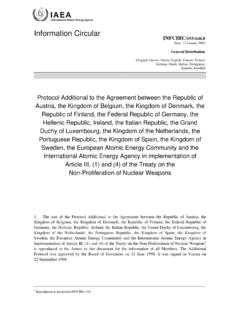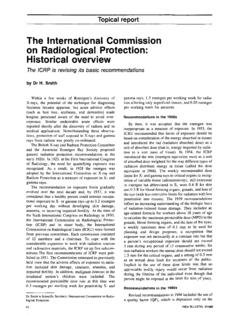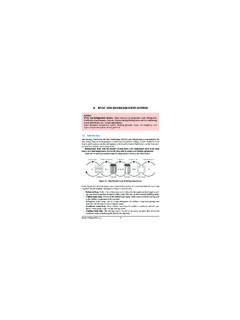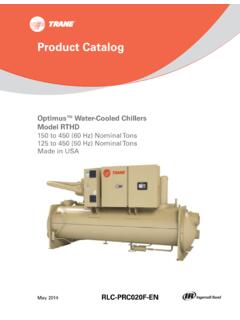Transcription of Radioactive waste management at nuclear power plants
1 FeaturesRadioactive waste managementat nuclear power plantsAn overview of the types of low- and intermediate-levelwastes and how they are handledby V. M. EfremenkovIn many countries nuclear power plants are an impor-tant part of the national energy system. nuclear poweris economically competitive and environmentally cleancompared to most other forms of energy used in electric-ity production. Used in conjunction with them, it con-tributes to the security of national electricity supplies. Itseems certain that in the medium term and beyond, agrowing contribution to national energy supplies fromnuclear energy will continue to be necessary if the stan-dard of living in industrialized countries of the world isto be maintained and the energy needs of the developingcountries are to be a result of the operation of nuclear reactors, someradioactive wastes are produced.
2 Yet compared to theamount of waste produced by coal-fired electrical gener-ating plants , these are of considerably smaller volume.(See table.) The wastes generated at nuclear powerplants are rather low in activity and the radionuclidescontained therein have a low radiotoxicity and usually ashort half-life. However, nuclear power plants are thelargest in number among all nuclear facilities andproduce the greatest volume of Radioactive nature and amounts of wastes produced in anuclear power plant depend on the type of reactor, itsspecific design features, its operating conditions and onthe fuel integrity.
3 These Radioactive wastes contain acti-vated radionuclides from structural, moderator, andcoolant materials; corrosion products; and fissionproduct contamination arising from the fuel. Themethods applied for the treatment and conditioning ofwaste generated at nuclear power plants now havereached a high degree of effectivity and reliability andare being further developed to improve safety andeconomy of the whole waste management generated at nuclear power plantsLow- and intermediate-level Radioactive waste (LILW) at nuclear power plants is produced by contami-nation of various materials with the radionuclides gener-ated by fission and activation in the reactor or releasedMr Efremenkov is a senior staff member in the IAEA Division ofNuclear Fuel Cycle and waste the fuel or cladding surfaces.
4 The radionuclides areprimarily released and collected in the reactor coolantsystem and, to a lesser extent, in the spent fuel main wastes arising during the operation of anuclear power plant are components which are removedduring refuelling or maintenance (mainly activatedsolids, stainless steel containing cobalt-60 andnickel-63) or operational wastes such as radioactiveliquids, filters, and ion-exchange resins which are con-taminated with fission products from circuits containingliquid order to reduce the quantities of waste for interimstorage and to minimize disposal cost, all countries arepursuing or intend to implement measures to reduce thevolume of waste arisings where practicable.
5 Volumereduction is particularly attractive for low-level wastewhich is generally of high volume but low radiationactivity. Significant improvements can be made throughadministrative measures, replacement of papertowels by hot air driers, introduction of reusable long-lasting protective clothing, etc., and through generalimprovements of operational implementation or"housekeeping".Liquid wastes and wet solid wastesAccording to the of reactors now oper-ating commercially all over the world, different wastestreams arise. These streams are different both inactivity content and in the amount of liquid waste gener-ated.
6 Reactors cooled and moderated by water generatemore liquid waste than those cooled by gas. Thevolumes of liquid waste generated at boiling-water reac-tors (BWRs) are significantly higher than at pressurized-water reactors (PWRs). Because the cleanup system ofheavy-water reactors (HWRs) works mainly with once-through ion-exchange techniques to recycle heavywater, virtually no liquid concentrates are generated liquid wastes are generated by the cleanup ofprimary coolants (PWR, BWR), cleanup of the spentfuel storage pond, drains, wash water, and leakagewaters. Decontamination operations at reactors alsoIAEA BULLETIN, 4/198937 Featuresgenerate liquid wastes resulting from maintenanceactivities on plant piping and equipment.
7 Decontamina-tion wastes can include crud (corrosion products) and awide variety of organics, such as oxalic and citric solids are another category of waste generated atnuclear power plants . They include different kinds ofspent ion-exchange resins, filter media, and resins constitute the most significant fraction ofthe wet solid waste produced at power reactors. Beadresins are used in deep demineralizers and are commonin nuclear power plants . Powdered resins are seldomused in PWRs, but are commonly used in BWRs withpre-coated filter demineralizers. In many BWRs, a largesource of powdered resin wastes are the "condensatepolishers" used for additional cleaning of condensedwater after evaporation of liquid filters used at nuclear power plants toprocess liquid waste produce another type of wet solidwaste-filter sludges.
8 The filter aids usually diato-maccous earth or cellulose fibres and the crud that isremoved from the liquid waste together form the filtersludges. Some filtration systems do not require filter aidmaterials. The sludges arising from such units thereforedo not contain other and conditioning of liquid/solid wasteLiquid Radioactive waste generated at nuclear powerplants usually contains soluble and insoluble radioactivecomponents (fission and corrosion products) and non- Radioactive substances. The general objective of wastetreatment methods is to decontaminate liquid waste tosuch an extent that the decontaminated bulk volume ofaqueous waste can be either released to the environmentor recycled.
9 waste concentrate is subject to further con-ditioning, storage, and disposal. Because nuclear powerplants generate almost all categories of liquid waste ,nearly all processes are applied to treat radioactiveeffluents. Standard techniques are routinely used todecontaminate liquid waste streams. Each process has aparticular effect on the Radioactive content of the extent to which these are used in combinationdepends on the amount and source of main technical processes are available for treat-ment of liquid waste : evaporation; chemical precipita-tion/flocculation; solid-phase separation; and treatment techniques are well established andwidely used.
10 Nevertheless, efforts to improve safety andeconomy on the basis of new technologies are under wayin many best volume reduction effect, compared with theother techniques, is achieved by evaporation. Dependingon the composition of the liquid effluents and the typesof evaporators, decontamination factors between 104and 106 are is a proven method for the treatment ofliquid Radioactive waste providing both good decontami-nation and volume reduction. Water is removed in thevapour phase of the process leaving behind non-volatilecomponents such as salts containing most is probably the best technique for wasteshaving relatively high salt content with a wide hetero-genous chemical composition.
















